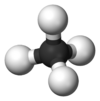Chemistry:Triazane

| |
| Names | |
|---|---|
| Systematic IUPAC name
Triazane[1] | |
| Identifiers | |
3D model (JSmol)
|
|
| ChemSpider | |
PubChem CID
|
|
| |
| |
| Properties | |
| N 3H 5 | |
| Molar mass | 47.061 g·mol−1 |
| Related compounds | |
Related compounds
|
|
Except where otherwise noted, data are given for materials in their standard state (at 25 °C [77 °F], 100 kPa). | |
| Infobox references | |
Triazane is an inorganic compound with the chemical formula NH
2NHNH
2 or N
3H
5.[2] Triazane is the third simplest acyclic azane after ammonia and hydrazine. It can be synthesized from hydrazine but is unstable and cannot be isolated in the free base form, only as salt forms such as triazanium sulfate. Attempts to convert triazanium salts to the free base release only diazene and ammonia.[3] Triazane was first synthesized as a ligand of the silver complex ion: tris(μ2-triazane-κ2N1,N3)disilver(2+).[clarification needed] Triazane has also been synthesized in electron-irradiated ammonia ices and detected as a stable gas-phase product after sublimation.[4]
Compounds containing the triazane skeleton
Several compounds containing the triazane skeleton are known, including 1-methyl-1-nitrosohydrazine (NH
2–N(CH
3)–N=O), produced from the solventless reaction of methylhydrazine (CH
3NHNH
2) and an alkyl nitrite (R–O–N=O):
- CH
3NHNH
2 + RONO → NH
2N(CH
3)NO + ROH
1-Methyl-1-nitrosohydrazine is a colorless solid, sensitive to impact, but not to friction. It melts at 45°C and decomposes at 121°C.
References
- ↑ "triazane - PubChem Public Chemical Database". The PubChem Project. USA: National Center for Biotechnology Information. https://pubchem.ncbi.nlm.nih.gov/summary/summary.cgi?cid=446953.
- ↑ IUPAC Goldbook
- ↑ Wiberg, Holleman & Wiberg. Inorganic Chemistry. p 627. ISBN:9780123526519
- ↑ Förstel, Maksyutenko, Jones, Sun, Chen, Chang, & Kaiser. "Detection of the Elusive Triazane Molecule ([N3H5]) in the Gas Phase", ChemPhysChem, 2015, 16, 3139.
External links
- 1-methyl-1-nitrosohydrazine, shows structure of 1-methyl-1-nitrosohydrazine
 |








